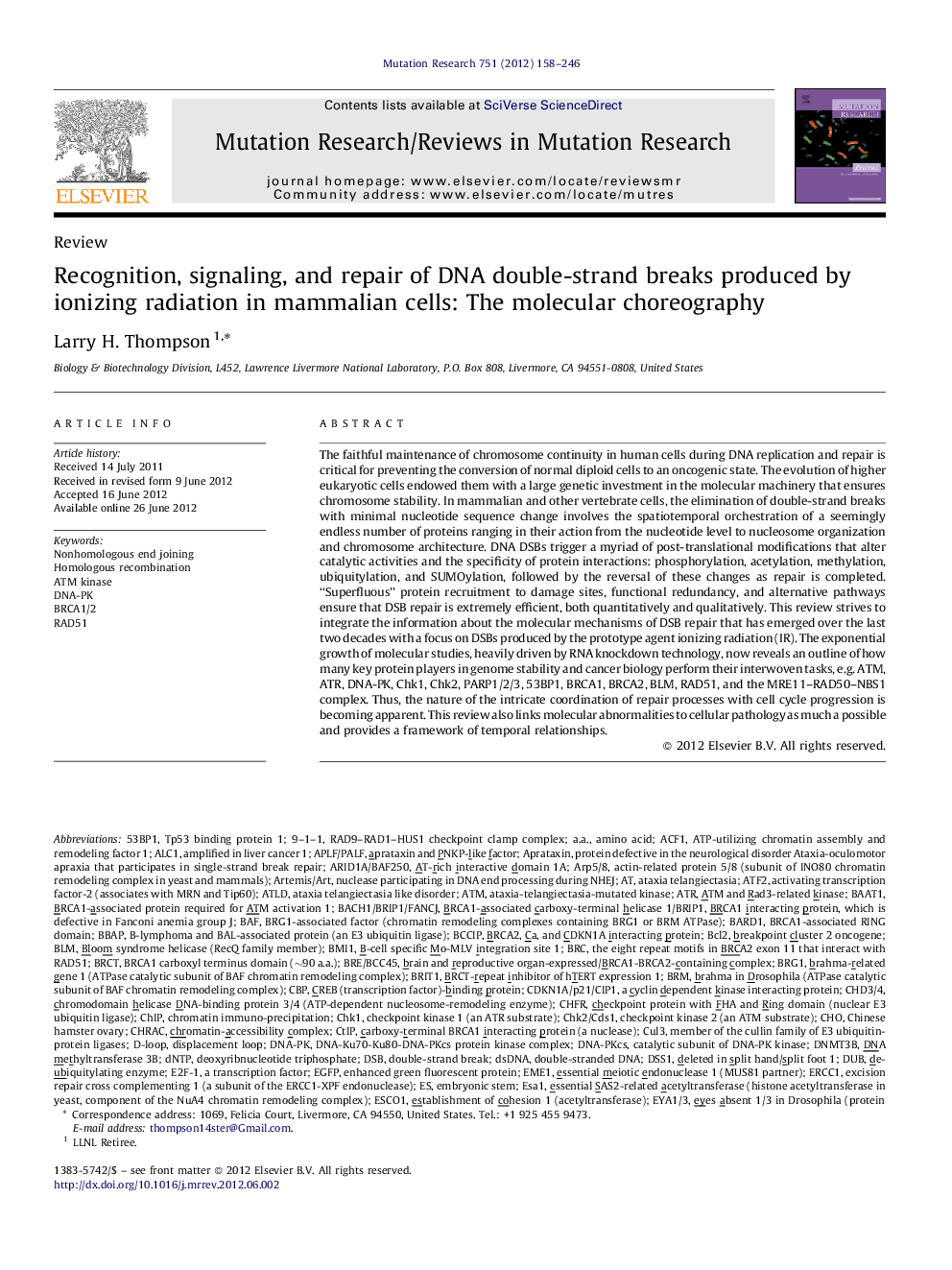| کد مقاله | کد نشریه | سال انتشار | مقاله انگلیسی | نسخه تمام متن |
|---|---|---|---|---|
| 10915288 | 1089880 | 2012 | 89 صفحه PDF | دانلود رایگان |
عنوان انگلیسی مقاله ISI
Recognition, signaling, and repair of DNA double-strand breaks produced by ionizing radiation in mammalian cells: The molecular choreography
دانلود مقاله + سفارش ترجمه
دانلود مقاله ISI انگلیسی
رایگان برای ایرانیان
کلمات کلیدی
DSBHRRdsDNAATRMMCPCCMOFMEFGFPeGFPFRAPNHEJBRCBRMBAFBLMP300CBPBcl2PARPATF2MRNBrg1dNTPDNMT3BCHFRPHF1DNA methyltransferase 3Bp14ARFPHDBARD1BCCIPH2AXMus81Chk1a.a.CUL3FHALIG4Ataxia telangiectasiaHus1BRCTDNA-PKKBD53BP1DNA-PKcsMG1329–1–1MSLDUBNPM1NuA4GCN5HP1ISWIKAP1MMEJNuRDALC1MUM1FANCPIASE2F-1Fe65DSS1CtIPMRG15INO80Mms2AprataxinEsa1Eme1PCNAPFGEPolynucleotide kinase/phosphataseGEN1PNKPCHRACBmi1 - BMI1double-stranded DNA - DNA رشته ایhTERT - htertPIKK - LIKKNAD+ - NAD +amino acid - آمینو اسیدoligonucleotide/oligosaccharide binding - اتصال الیگونوکلئوتید / اولیگوساکاریدLET - اجازه دهیدPulse field gel electrophoresis - الکتروفورز ژل فیلد پالسLinear Energy Transfer - انتقال انرژی خطیATLD - بالاCho - برایionizing radiation - تابش یوننده یا پرتوهای یونیزانChinese Hamster Ovary - تخمدان هامستر چینیPremature chromosome condensation - تراکم کروموزوم زودرسHomologous recombination repair - تعمیر مجدد هومولوگhuman telomerase reverse transcriptase - تلومراز انسانی معکوس transcriptasePar - توسطD-loop - حلقه Ddisplacement loop - حلقه جابجاییATM - خودپردازembryonic stem - ساقه جنینNijmegen breakage syndrome 1 - سندرم شکستن نیهمگن 1double-strand break - شکست دو ردیفfluorescence recovery after photobleaching - فلوئورسانس پس از فوتوبلاسیکprotein inhibitor of activated Stat - مهارکننده پروتئین فعال شدهmouse embryonic fibroblast - موش فیبروبلاست جنینیNucleophosmin 1 - نوکلئوفسمی 1nicotinamide adenine dinucleotide - نیکوتین آمید adenine dinucleotideHistone acetyltransferase - هیستون استیل ترانسفرازPatm - پتمgreen fluorescent protein - پروتئین فلورسنت سبزenhanced green fluorescent protein - پروتئین فلورسنت سبز افزایش یافته استheterochromatin protein 1 - پروتئین هتروکروماتین 1Poly(ADP-ribose) - پلی (ADP-ribose)microhomology-mediated end joining - پیوستن انتهای میکرومولوژیکNonhomologous end joining - پیوستن به انتهای غیرخطیCHiP - چیپERCC1 - ژن ERCC1KRAB - کراوبChromatin Immuno-Precipitation - کروماتین ایمنی-بارشHAT - کلاهFanconi anemia - کم خونی Fanconi
موضوعات مرتبط
علوم زیستی و بیوفناوری
بیوشیمی، ژنتیک و زیست شناسی مولکولی
تحقیقات سرطان
پیش نمایش صفحه اول مقاله

چکیده انگلیسی
The faithful maintenance of chromosome continuity in human cells during DNA replication and repair is critical for preventing the conversion of normal diploid cells to an oncogenic state. The evolution of higher eukaryotic cells endowed them with a large genetic investment in the molecular machinery that ensures chromosome stability. In mammalian and other vertebrate cells, the elimination of double-strand breaks with minimal nucleotide sequence change involves the spatiotemporal orchestration of a seemingly endless number of proteins ranging in their action from the nucleotide level to nucleosome organization and chromosome architecture. DNA DSBs trigger a myriad of post-translational modifications that alter catalytic activities and the specificity of protein interactions: phosphorylation, acetylation, methylation, ubiquitylation, and SUMOylation, followed by the reversal of these changes as repair is completed. “Superfluous” protein recruitment to damage sites, functional redundancy, and alternative pathways ensure that DSB repair is extremely efficient, both quantitatively and qualitatively. This review strives to integrate the information about the molecular mechanisms of DSB repair that has emerged over the last two decades with a focus on DSBs produced by the prototype agent ionizing radiation (IR). The exponential growth of molecular studies, heavily driven by RNA knockdown technology, now reveals an outline of how many key protein players in genome stability and cancer biology perform their interwoven tasks, e.g. ATM, ATR, DNA-PK, Chk1, Chk2, PARP1/2/3, 53BP1, BRCA1, BRCA2, BLM, RAD51, and the MRE11-RAD50-NBS1 complex. Thus, the nature of the intricate coordination of repair processes with cell cycle progression is becoming apparent. This review also links molecular abnormalities to cellular pathology as much a possible and provides a framework of temporal relationships.
ناشر
Database: Elsevier - ScienceDirect (ساینس دایرکت)
Journal: Mutation Research/Reviews in Mutation Research - Volume 751, Issue 2, OctoberâDecember 2012, Pages 158-246
Journal: Mutation Research/Reviews in Mutation Research - Volume 751, Issue 2, OctoberâDecember 2012, Pages 158-246
نویسندگان
Larry H. Thompson,